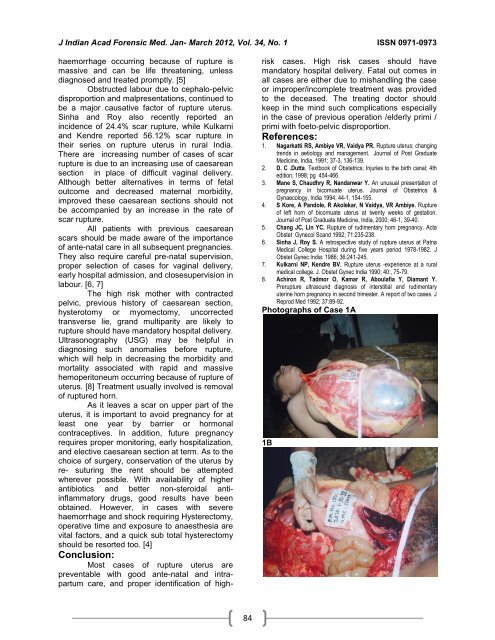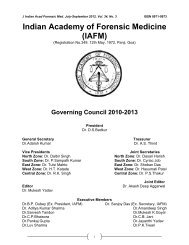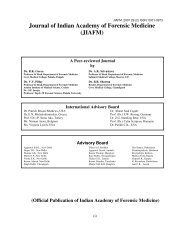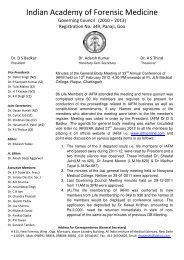Indian Academy of Forensic Medicine (IAFM) - Official website of IAFM
Indian Academy of Forensic Medicine (IAFM) - Official website of IAFM
Indian Academy of Forensic Medicine (IAFM) - Official website of IAFM
You also want an ePaper? Increase the reach of your titles
YUMPU automatically turns print PDFs into web optimized ePapers that Google loves.
J <strong>Indian</strong> Acad <strong>Forensic</strong> Med. Jan- March 2012, Vol. 34, No. 1 ISSN 0971-0973<br />
haemorrhage occurring because <strong>of</strong> rupture is<br />
massive and can be life threatening, unless<br />
diagnosed and treated promptly. [5]<br />
Obstructed labour due to cephalo-pelvic<br />
disproportion and malpresentations, continued to<br />
be a major causative factor <strong>of</strong> rupture uterus.<br />
Sinha and Roy also recently reported an<br />
incidence <strong>of</strong> 24.4% scar rupture, while Kulkarni<br />
and Kendre reported 56.12% scar rupture in<br />
their series on rupture uterus in rural India.<br />
There are increasing number <strong>of</strong> cases <strong>of</strong> scar<br />
rupture is due to an increasing use <strong>of</strong> caesarean<br />
section in place <strong>of</strong> difficult vaginal delivery.<br />
Although better alternatives in terms <strong>of</strong> fetal<br />
outcome and decreased maternal morbidity,<br />
improved these caesarean sections should not<br />
be accompanied by an increase in the rate <strong>of</strong><br />
scar rupture.<br />
All patients with previous caesarean<br />
scars should be made aware <strong>of</strong> the importance<br />
<strong>of</strong> ante-natal care in all subsequent pregnancies.<br />
They also require careful pre-natal supervision,<br />
proper selection <strong>of</strong> cases for vaginal delivery,<br />
early hospital admission, and closesupervision in<br />
labour. [6, 7]<br />
The high risk mother with contracted<br />
pelvic, previous history <strong>of</strong> caesarean section,<br />
hysterotomy or myomectomy, uncorrected<br />
transverse lie, grand multiparity are likely to<br />
rupture should have mandatory hospital delivery.<br />
Ultrasonography (USG) may be helpful in<br />
diagnosing such anomalies before rupture,<br />
which will help in decreasing the morbidity and<br />
mortality associated with rapid and massive<br />
hemoperitoneum occurring because <strong>of</strong> rupture <strong>of</strong><br />
uterus. [8] Treatment usually involved is removal<br />
<strong>of</strong> ruptured horn.<br />
As it leaves a scar on upper part <strong>of</strong> the<br />
uterus, it is important to avoid pregnancy for at<br />
least one year by barrier or hormonal<br />
contraceptives. In addition, future pregnancy<br />
requires proper monitoring, early hospitalization,<br />
and elective caesarean section at term. As to the<br />
choice <strong>of</strong> surgery, conservation <strong>of</strong> the uterus by<br />
re- suturing the rent should be attempted<br />
wherever possible. With availability <strong>of</strong> higher<br />
antibiotics and better non-steroidal anti-<br />
inflammatory drugs, good results have been<br />
obtained. However, in cases with severe<br />
haemorrhage and shock requiring Hysterectomy,<br />
operative time and exposure to anaesthesia are<br />
vital factors, and a quick sub total hysterectomy<br />
should be resorted too. [4]<br />
Conclusion:<br />
Most cases <strong>of</strong> rupture uterus are<br />
preventable with good ante-natal and intrapartum<br />
care, and proper identification <strong>of</strong> high-<br />
84<br />
risk cases. High risk cases should have<br />
mandatory hospital delivery. Fatal out comes in<br />
all cases are either due to mishandling the case<br />
or improper/incomplete treatment was provided<br />
to the deceased. The treating doctor should<br />
keep in the mind such complications especially<br />
in the case <strong>of</strong> previous operation /elderly primi /<br />
primi with foeto-pelvic disproportion.<br />
References:<br />
1. Nagarkatti RS, Ambiye VR, Vaidya PR. Rupture uterus: changing<br />
trends in aetiology and management. Journal <strong>of</strong> Post Graduate<br />
<strong>Medicine</strong>, India, 1991; 37-3, 136-139.<br />
2. D. C .Dutta. Textbook <strong>of</strong> Obstetrics; Injuries to the birth canal; 4th<br />
edition, 1998; pg 454-466.<br />
3. Mane S, Chaudhry R, Nandanwar Y. An unusual presentation <strong>of</strong><br />
pregnancy in bicornuate uterus. Journal <strong>of</strong> Obstetrics &<br />
Gynaecology, India 1994; 44-1, 154-155.<br />
4. S Kore, A Pandole, R Akolekar, N Vaidya, VR Ambiye. Rupture<br />
<strong>of</strong> left horn <strong>of</strong> bicornuate uterus at twenty weeks <strong>of</strong> gestation.<br />
Journal <strong>of</strong> Post Graduate <strong>Medicine</strong>, India, 2000; 46-1, 39-40.<br />
5. Chang JC, Lin YC. Rupture <strong>of</strong> rudimentary horn pregnancy. Acta<br />
Obstet Gynecol Scand 1992; 71:235-238.<br />
6. Sinha J, Roy S. A retrospective study <strong>of</strong> rupture uterus at Patna<br />
Medical College Hospital during five years period 1978-1982. J<br />
Obstet Gynec India: 1986; 36:241-245.<br />
7. Kulkarni NP, Kendre BV. Rupture uterus -experience at a rural<br />
medical college. J. Obstet Gynec India 1990; 40:, 75-79.<br />
8. Achiron R, Tadmor O, Kamar R, Aboulafia Y, Diamant Y.<br />
Prerupture ultrasound diagnosis <strong>of</strong> interstitial and rudimentary<br />
uterine horn pregnancy in second trimester. A report <strong>of</strong> two cases. J<br />
Reprod Med 1992; 37:89-92.<br />
Photographs <strong>of</strong> Case 1A<br />
1B









